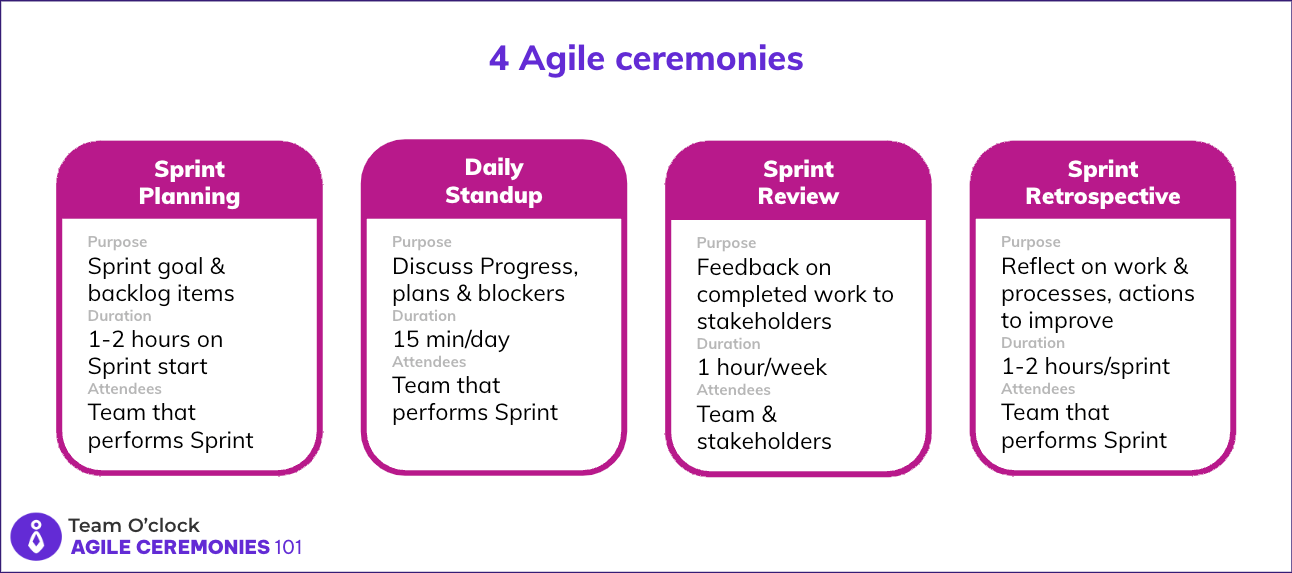
A Quick, Expert Guide for all Agile Ceremonies

Agile methodologies have transformed how teams approach project management, emphasizing the importance of adaptability, collaboration, and continuous improvement.
Its ceremonies are central to the Agile framework. They refer to structured events designed to enhance communication, collaboration, and transparency among team members.
In this guide, you will discover the breakdown of all agile ceremonies and expert tips for optimizing Sprint Planning, Daily Stand-up, Sprint Review, and Sprint Retrospective.
What You Need to Know About the Agile Ceremonies

1. Sprint Planning
Sprint planning sets the stage for a successful sprint by aligning the team's efforts with project goals and priorities.
Overview: Sprint planning marks the beginning of each sprint, where the team plans the work to be completed and determines the focus point of the next few weeks.
Structure: Typically divided into two parts: discussing the sprint goal and selecting items from the product backlog.
Duration: Usually lasts 1-2 hours, depending on the sprint's length and the work's complexity.
Attendees: Entire Agile team, including developers, product owner, and SCRUM master.
Timing: Held at the start of each sprint.
Agile Framework: Integral part of SCRUM.
Benefits: It ensures alignment on sprint goals, promotes collaboration and provides clarity on tasks.
Here are 3 Expert Tips to Keep in Mind:
Prioritize effectively: Start by identifying and prioritizing backlog items based on their importance and value to the project.
Engage the whole team: Foster collaboration by involving all team members in the planning process, ensuring a shared understanding of goals and tasks.
Break it down: Break down user stories into manageable tasks, making estimating and tracking progress throughout the sprint easier.
2. Daily Stand-up or Daily SCRUM
The daily stand-up keeps the team aligned, connected and focused on delivering value.
Overview: A brief daily meeting where team members discuss progress, plans, and blockers.
Structure: Each team member answers three questions: What did I accomplish yesterday? What will I do today? Are there any obstacles?
Duration: Typically lasts 15 minutes to keep it concise and focused. For asynchronous teams, where members are located in different time zones and responding times are not immediate, the Daily Stand-up can last from 4 to 12 hours.
Attendees: Entire Agile team, including developers, product owner, and scrum master.
Timing: Held daily, preferably at the start of the workday.
Agile Framework: Integral part of Scrum and Kanban.
Benefits: It facilitates communication, identifies and removes blockers, and promotes accountability.
Three Expert Tips for a Successful Daily Stand-up
Keep it concise: During synchronous meetings, maintain a strict time-box of 15 minutes to keep discussions focused and avoid unnecessary delays. During asynchronous meetings, communicate clearly to avoid misunderstandings or significant delays.
Focus on relevance: Encourage team members to share updates relevant to the entire team, avoiding tangents or detailed discussions.
Encourage active listening: Foster a culture of active listening and empathy, ensuring everyone speaks and is heard.
3. Sprint Review
The sprint review provides an opportunity to demonstrate completed work, gather feedback, and validate project direction and progress.
Overview: At the end of each sprint, the team demonstrates completed work to stakeholders and receives feedback.
Structure: Showcase of completed user stories and features, followed by feedback and discussion.
Duration: Typically lasts one hour per week of the sprint duration, depending on the scope of the sprint and stakeholder involvement.
Attendees: Entire Agile team, stakeholders, and any other relevant parties.
Timing: Held at the end of each sprint.
Agile Framework: Integral part of Scrum.
Benefits: It validates work against stakeholder expectations, gathers valuable feedback, and promotes transparency.
Here's How to Make the Most of the Sprint Review:
Polish your demo: Prepare a polished and engaging demo that highlights the value delivered during the sprint, capturing stakeholders' attention and interest.
Engage stakeholders: Encourage active participation from stakeholders, asking for feedback and insights to inform future iterations and improvements.
Focus on outcomes: Shift the focus from outputs to outcomes, emphasizing the value delivered to end-users and stakeholders.
4. Sprint Retrospective
The sprint retrospective promotes a culture of continuous improvement by reflecting on past performance and identifying growth opportunities.
Overview: A meeting performed at the end of each sprint to reflect on what went well, what could be improved, and identify action items.
Structure: Three main phases: What went well, what could be improved, and action planning.
Duration: Typically lasts 1-2 hours, depending on the depth of discussion and number of action items.
Attendees: Entire Agile team, including developers, product owner, and scrum master.
Timing: Held at the end of each sprint, after the sprint review.
Agile Framework: Integral part of Scrum.
Benefits: Promotes continuous improvement, fosters team collaboration, and increases accountability.
How to Ensure Productive Retrospectives:
Create a safe space: Foster a safe and supportive environment where team members feel comfortable sharing feedback, insights, and concerns.
Focus on action: Identify actionable insights and concrete steps for improvement, ensuring that discussions lead to tangible outcomes and changes.
Follow up: Hold team members accountable for implementing agreed-upon action items, tracking progress, and revisiting them in future retrospectives.
Takeaway
Agile ceremonies are vital in promoting collaboration, transparency, and continuous improvement within Agile teams. By following these expert tips, your team can enhance the effectiveness of your Agile ceremonies and maximize their chances of project success.

More articles to check

Assist your team's growth with our partnership program:








